




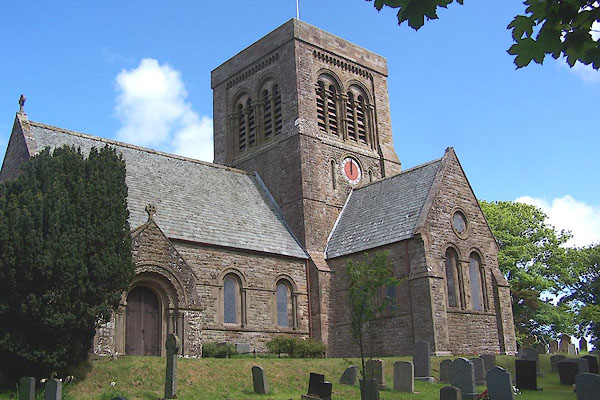
BNR76.jpg (taken 25.5.2007)
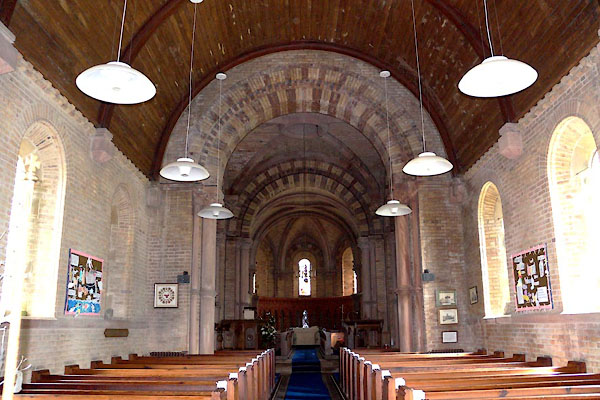
CAU50.jpg (taken 30.5.2014)
placename:- St Bridget's Church
"St. Bridget's Church (Vicarage) / Grave Yard"
placename:- Bedkirk Church
item:- font; inscription, danish
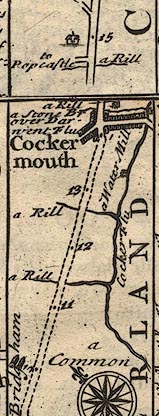
B261m10.jpg
"At Pap Castle abt. 2 Miles off [from Cockermouth], among other Monuments of Antiquity, was lately found a large open Vessel of Green stone, adorned wth. curious Imagery. That on ye East side of it representing a Person in a Sacerdotal Habit dipping a Child in Water (wch. was ye primitive way of administring Baptism evinces it to be Christian, And ye Learned Antiquary Dr. Nicholson from ye Intricate Dano Saxonic Inscription on it wch. he first explained, supposes it to be an ancient Font, intended as a Monument of ye Baptism) of one Ekard (a General or person of Note among ye Danes) who as ye Inscription mentions being converted here influenced a great many Persons by his example. This Vessel is now used as a Font Bedkirk Church."
item:- Dove Cottage : Lowther.36
Image © see bottom of page
item:- font; baptism
 goto source
goto sourceGentleman's Magazine 1739 p.11 "DIPPING the Proper BAPTISM."
"... ..."
"That Baptism was administered by Immersion in the Scripture Times, is confess'd by many, that to this Day adhere to the Innovation of Sprinkling, and that it was performed this Way in After-Times I may prove (by way of Appendix to the many Testimonies I before gave) from that famous old Font at Bridekirk in Cumberland, which seems by the Inscription to be erected upon the most early Conversion of the Saxons to Christianity; where, as Bishop Nicholson observes, 'we have on the East Side fairly represented a Person in a long sacerdotal Habit dipping a Child into the Water, and a Dove, (the Emblem, no doubt, of the Holy Ghost) hovering over the Infant.' They are the Words of the Bishop to Sir William Dugdale, that famous Antiquarian, and may be found in Gibson's Cambden, p.841. ..."
In a letter by Marcus written 16 October 1738.
item:- font; runes
 goto source
goto sourceGentleman's Magazine 1749 p.152
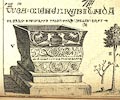 click to enlarge
click to enlargeG749E01.jpg
Caption p.152:- "FIG V. The view of an ancient font at Bridekirk in Cumberland, with a Runic inscription, of which we expect a further account."
item:- Papcastle
 goto source
goto sourceGentleman's Magazine 1749 p.217 "... ..."
"A Description of FIG. V. in the Miscellaneous Plate in last Magazine."
"Mr URBAN,"
"THIS curious piece of antiquity was dug up in the ruins of Papcastle, near Cockermouth, in Cumberland, among other antique remains. The author of Magna Britannia, &c. says, "What use it was made for, does not appear, but 'tis now used for a baptismal font (called by St Austin sacrarium regenerationis, the sacred laver of regeneration, and, probably, it was design'd for one." He adds, that it is of green stone, but it is really a whitish free-stone. (See Vol.XII. p.319 a greater mistake of this writer.) It stands in a square pedestal, about 8 inches high in the upright, and about three more in the perpendicular of the slope; this supports another of about 20 inches more, pretty near a cube hollow'd, being 22 inches on the South and North sides, and 20 on the other two."
"It faces the porch door of Bridekirk, is lined with lead, and perforated at bottom to take off the baptismal water, and must be at least 900 years standing."
"The front, or South side, engraving is betwixt 3 fillets; the uppermost, I imagine, contains two AEgoceri, or sea-goats, the ancient representation of Capricorn, in whose sign the sun was at the birth of Christ, and, probably, alludes to that; the middle fillet has a festoon of grapes, &c. and a human figure catching at a cluster, perhaps, to intimate the mystery of the passion, or of the Eucharist, and the advantages accruing to the partaker."
"Betwixt that and the third fillet is the inscription, and below a female figure with a cup, probably, in her hand; and some festoons."
"The East side has only two fillets, the uppermost contains an Amphisbaena, or a hydra rather, with two heads, one bent down over its body to the ground, the other erect, with a branch proceeding from its mouth, which in its process divides into three; the first head may denote the depression and extinction of the Mosaic scheme, the other the erection of the Christian one, and the mystery of the Trinity may be express's in the branch dividing into three, and both may be represented by the hydra."
"The second fillet has a tree, and Joseph and Mary, I suppose, with the child, as Joseph is call'd a fruitful branch."
"The North side confirms my conjectures on that of the South, where the two coelestial signs of Capricorn and Sagittary are represented; Sagittary is the concluding sign of the year, as Capricorn the initial one with regard to the solar return; intimating that the religion which sprung from the person born when the sun was in Capricorn, would continue to the consummation of things, or till the sun had gone into Sagittary, their emblem of the last period."
"The fillet below, on the same side, has an allusion to the slaughter of the babes at Bethlehem, and a devotee in a religious posture kneeling, and taking hold of the true tree of life, notwithstanding the loss of her child, as the only means of her future acceptace and happiness."
"The West side is in the same taste, but the figures wasted by time."
"The learned Bp Nicolson supposes the Runic inscription should be read thus."
"
And to dis men red wor tanen men brogten."
"In ENGLISH"
"Here Ekardwas converted, and to this man's example were Danishmen brought."
"He conjectures that Ekard was a Danish general, who being baptized at this font, was the occasion of many of his officers and soldiers becoming Christians."
"The Bishop is of opinion that the figures by way of embellishment, are only the fancy of the workman; but I am persuaded that they have an emblematical meaning, which can at this time only be conjectured."
"... ..."
placename:- Bride Kirk
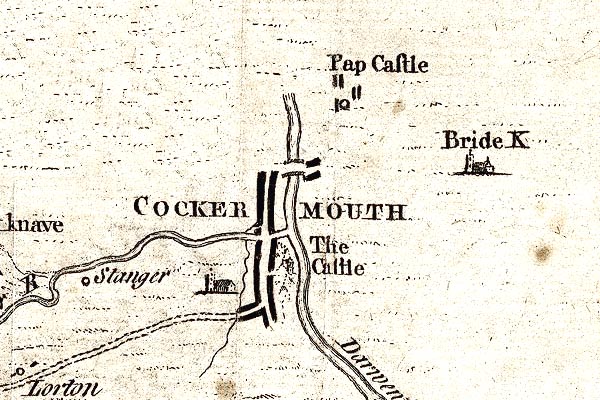
GM1304.jpg
"Bride K"
church
item:- JandMN : 114
Image © see bottom of page
placename:- St Brigit's Church
item:- font
 goto source
goto sourcePage 170:- "..."
"... an old castle called Pap castle, ... Among other monuments of antiquity here was found a large vase of greenish stone, handsomely carved with small figures; whether designed for the purpose of washing, or as St. Ambrose calls it sacrarium regenerationis, that laver of regeneration, for which use it now serves at the neighbouring town of Bridkirk, q.d. St. Brigit's church, I shall not pronounce. We find fonts adorned with the figures of saints in order to set forth their example to the imitation of the persons baptized. On this besides figures are these foreign characters: See Pl.VIII. fig.I. What they mean or to what nation they belong I do not take upon me to say. Let the learned determine. The first and eighth are not very unlike the character used by Christians after the time of Constantine for the name of Christ. The rest in form but not in power come nearest those which are to be seen on the tomb of Gormon king of Denmark, at Jelling in Denmark, as published by Petrus Lindenbrogius 1591."
placename:-
item:- font, Bridekirk; runes
 goto source
goto sourcePage 183:- "..."
"The font at Bridekirk was copied for the late bishop Lyttelton, and engraved in Archaeol. II. p.131. It exhibits in rude relief the expulsion of Adam and Eve out of Paradise, and the baptism of Christ, over which may perhaps be the serpent with the forbidden fruit. The other two sides are charged with grotesques and foliage, and on the south is the inscription in Runic characters on a scroll. Bishop Nicolson in a long and learned letter to sir William Dugdale 1685, reads it Er Ekard men egroten & to dis men red wer Taner men brogten; which he explains, Here Ekard was converted, and to this man's example were the Danes brought. He considers the characters a mixture of Runic and Saxon, and the language made up of Danish and Saxon. Bishop Lyttelton imagines the font older than the event here commemorated, and the inscription added at the time it happened, though he justly doubted its being found at Pap castle, as it could have no connection with that station. Ekard might give the font after his conversion. Wormius gave a very different explanation in a letter to Spelman 1634. Haraldus cumulum fecit &lapides erexit in memoriam matris amp; Mabroki; which gives the letters from Camden's copy so different from bishop Nicolson that one would doubt if they had ever been truly copied. Camden's letters are certainly incorrect to a degree, and Wormius had no other copy; whereas bishop Nicolson professes to have exactly written them out from the stone. Dr, Hickes in a letter to bishop Nicolson says, the letters seem to be Dano-Saxonic, consequently neither good Danish nor good Saxon. On comparing the three copies of Camden, Wormius, and Nicolson, it appears that Camden gives 36, Nicolson 34 (omitting the 30th and 31st, which in the Archaeologia copy by Mr. Ainsley"
 goto source
goto sourcePage 184:- "are supplied like Camden's), and Wormius 37, near half of which bear no resemblance to the others. Mr. Hutchinson's drawing of this font 1775 is the last, and bears no resemblance to the others, nor probably to the rudeness of the original, and the inscription is still less faithful. The copy of the letters here given from Mr. Bell, the rector, to Dr. Burn, may be presumed to be the most exact: he sent the drawings &c. to bishop Lyttelton as engraved."
"The father of sir Joseph Williamson, secretary of state to Charles II. and one of the plenipotentiaries at the treaty of Cologne 1674, and a great benefactor to Queen's college, Oxford, where he was educated, was rector of Bridekirk."
item:- font
 goto source
goto sourcePage 84:- "..."
"As Bridekirk is only two miles distant [from Papcastle], the antiquarian tourist ought to spare time for the purpose of inspecting the rare and curious Font in the parish church."
item:- font
 goto source
goto sourceGentleman's Magazine 1862 part 1 pp.592-593
page 592 "SOCIETY OF ANTIQUARIES, NEWCASTLE-UPON-TYNE."
"March 5. ..."
"A short paper by Mr. Monkhouse, was read on the font on Bridekirk Church. Mr. Monkhouse, after careful investigation, came to the con-"
page 593 "[con]clusion that the carving was Old-English, the language Old-English, and that the inscription was carved by Richard, Lord of Bridekirk, in the thirteenth century."
"... ..."
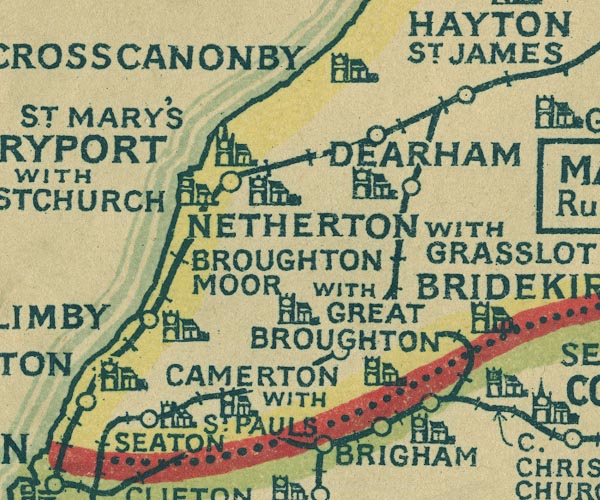
NUR1NY03.jpg
"BRIDEKIRK"
item:- JandMN : 27
Image © see bottom of page
 stained glass
stained glassplacename:- Church of St Bridget
courtesy of English Heritage
"RUIN OF CHURCH OF ST BRIDGET / / / BRIDEKIRK / ALLERDALE / CUMBRIA / II / 72573 / NY1171333706"
courtesy of English Heritage
"Parish Church now in ruins, within churchyard of present parish church. C12 with late C15 or early C16 alterations, made into ruin in late C19. Mixed calciferous and red sandstone blocks. Only the ruins of 3 chancel walls remain. East window of 3 rounded lights under hoodmould. Flat stone-mullioned south window under hoodmould. North wall with probable remains of vestry doorway and smaller blocked window or recess now covered by tomb. Interior has 2 east aumbries. Lintel of south window is medieval grave slab. A fire in the mid C19 necessitated the building of the present church."
placename:- Church of St Bride
courtesy of English Heritage
"CHURCH OF ST BRIDE / / / BRIDEKIRK / ALLERDALE / CUMBRIA / II / 72569 / NY1164833691"
courtesy of English Heritage
"Parish Church. 1868-70 by Cory and Ferguson of Carlisle. Rock-faced calciferous sandstone with string courses and clasping buttresses. Graduated greenslate roof with coped gables and cross finials. Cruciform, Neo-Norman, with apse. Nave has south porch with C19 zigzag arches on engaged columns. All windows are round-headed with engaged columns. Large square tower has mosaic clockface under 4-light bell openings on south side South transept has reused C12 zigzag-arched doorway from the old church and a built-in armorial stone from a tomb in the old church. Against the apse wall are 8 grave slabs and 2 Roman quern stones."
courtesy of English Heritage
"CROSS BASE AT EAST END OF CHURCH OF ST BRIDE / / / BRIDEKIRK / ALLERDALE / CUMBRIA / II / 72570 / NY1166433700"
courtesy of English Heritage
"Cross base. Mediaval Calciferous sandstone. Socket stone, one side broken, giving the appearance of having been used as a seat. Has group value with Church of St Bride."
courtesy of English Heritage
"TROHEAR AND PAITSON TOMBS EAST OF CHURCH OF ST BRIDE / / / BRIDEKIRK / ALLERDALE / CUMBRIA / II / 72571 / NY1168333698"
courtesy of English Heritage
"2 table tombs. Mid C18. Sandstone. Inscribed Joseph Paitson of Papcastle and Dorothy, Aug 1752 and Thomas Trohear 1742."
courtesy of English Heritage
"THOMPSON TOMB EAST OF CHURCH OF ST BRIDE / / / BRIDEKIRK / ALLERDALE / CUMBRIA / II / 72572 / NY1169233700"
courtesy of English Heritage
"Table tomb. l688. Long inscription to James Thompson of Broughton, 8 February, 1688."
item:- runes; font; Richard of Durham; tympanum; cross
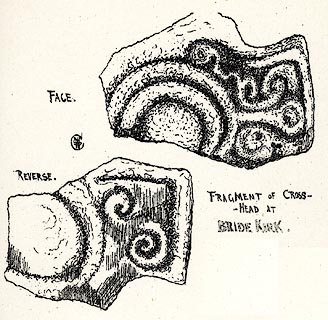 click to enlarge
click to enlargeCV1048.jpg
Typanum:-
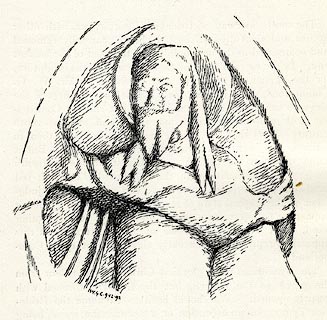 click to enlarge
click to enlargeCV1052.jpg
Sketch by W G Collingwood.
Font:-
 click to enlarge
click to enlargeCV1057.jpg
Photograph by W L Fletcher.
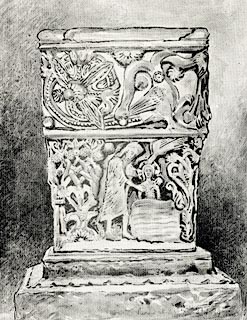 click to enlarge
click to enlargeCV1054.jpg
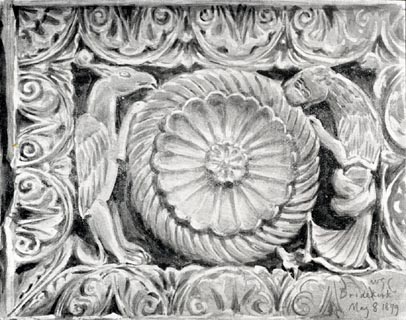 click to enlarge
click to enlargeCV1055.jpg
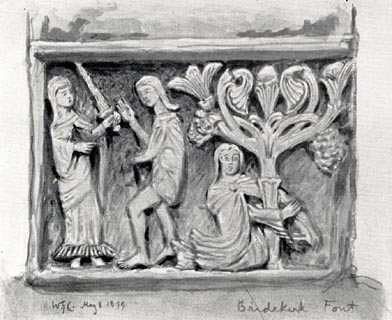 click to enlarge
click to enlargeCV1056.jpg
Sketches by W G Collingwood.
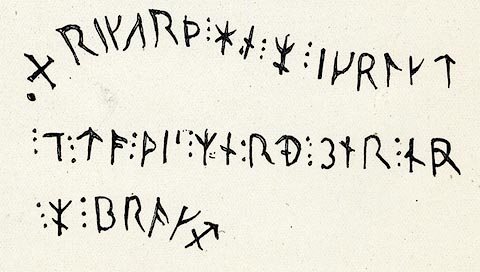 click to enlarge
click to enlargeCV1053.jpg
Tracing by W G Collingwood. "+ RIKARTH HE ME IWROKT[E] AND TO THIS MERTHE GERNR ME BROKTE"
"Richard, he me wrought, and to this beauty carefully me brought."
Richard of Durham was a famous architect and sculptor, about 1120-1180.
item:- JandMN : 190
Image © see bottom of page
item:- cross
 click to enlarge
click to enlargeCV1048.jpg
item:- JandMN : 190
Image © see bottom of page
item:- font; Garden of Eden
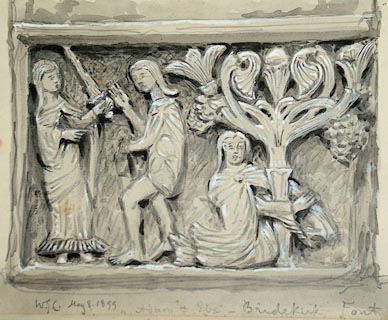 click to enlarge
click to enlargePR0848.jpg
Sketch of panel of font depicting Adam and Eve's expulsion from the Garden of Eden. To left, an angel bearing the flaming sword beckons them to accompany her; Adam comes forth whilst Eve, on right, clings kneeling to a stylised Tree of Life. The font dates from 12th century.
Drawn to illustrate Notes on the Early Sculptured Crosses, Shrines and Monuments in the Present Diocese of Carlisle, by Rev William Slater Calverley, published by T Wilson, Kendal 1899; opposite p.70.
initialled &dated at bottom left:- "W.G.C. May 8 1899"
inscribed at bottom centre:- "Adam and Eve - Bridekirk Font"
item:- Tullie House Museum : 1902.18.32
Image © Tullie House Museum
item:- font; griffin
 click to enlarge
click to enlargePR0847.jpg
Study of detail of font; a griffin and a sea monster supporting an orb framed by Greek Italian leaf moulding. The font dates from 12th centruy.
Drawn to illustrate Notes on the Early Sculptured Crosses, Shrines and Monuments in the Present Diocese of Carlisle, by Rev William Slater Calverley, published by T Wilson, Kendal 1899; opposite p.69.
initialled & inscribed &dated at bottom right:- "WGC Font, Bridekirk May 8 1899"
item:- Tullie House Museum : 1902.18.31
Image © Tullie House Museum
item:- tympanum
 click to enlarge
click to enlargePR0854.jpg
Sketch of carved figure of tympanum; Christ in glory, with double beard and divided locks flowing over either shoulder, fully robed, a nimbus surrounding his head. His arms are outstretched in blessing.
Drawn to illustrate Notes on the Early Sculptured Crosses, Shrines and Monuments in the Present Diocese of Carlisle, by Rev William Slater Calverley, published by T Wilson, Kendal 1899; opposite p.63.
initialled &dated at bottom left:- "W.G.C. 9.12.1892"
inscribed at bottom centre:- "Tympanum at BRIDEKIRK"
item:- Tullie House Museum : 1902.18.38
Image © Tullie House Museum
 click to enlarge
click to enlargeBMZ95.jpg
Nicolson and Burn vol.2 p.103:- "In the church of Bridekirk there is an ancient font, which Camden says was found in the ruins of Papcastle, ... Bishop Nicholson in his miscellany account of the diocese of Carlisle, taken in his parochial visitation in 1703, says, 'I took some pains in reviewing the Runic inscription on the font in this church ...' ... Mr. Bell, the present learned and very worthy incumbent ... hath also given us a very exact copy of the inscription ..."
item:- Dove Cottage : Lowther.61
Image © see bottom of page
 ring of bells
ring of bells cross slab gravestones
cross slab gravestones| Eboraco, Roger | |
| Urry, Robert | 1307 - |
| Wilton, Robert de | 1316 - |
| Delyngton, John de | 1380 - |
| Elletson, George | 1553 - |
| Wharton, Percival | |
| Robinson, William | 1563 - |
| Wheelwright, John | 1581 - |
| Williamson, John | 1625 - |
| Beeby, Nicholas | 1634 - |
| Benson, George | |
| Grasty, Samuel | 1660 - |
| Belman, Thomas | 1664 - |
| Tickell, Richard | 1680 - |
| King, David | 1685 - |
| Harrsion, John | 1720 - |
| Bell, John | 1755 - |
| Hervey, Humphrey A | 1795 - |
| Ballantine Dykes, Joseph | 1844 - |
| Steel, Joseph B | 1848 - |
| Fothergill, John | 1849 - |
| Carter, James | 1851 - |
| Sutton, Alfred | 1881 - |
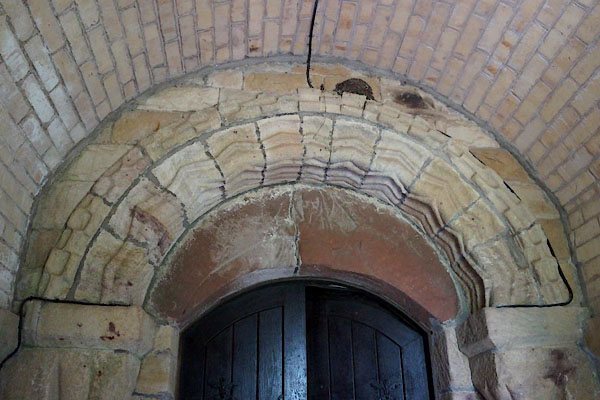
CAU44.jpg Door arch.
(taken 30.5.2014)

CAU70.jpg Organ.
(taken 30.5.2014)

CAU71.jpg Organ.
(taken 30.5.2014)
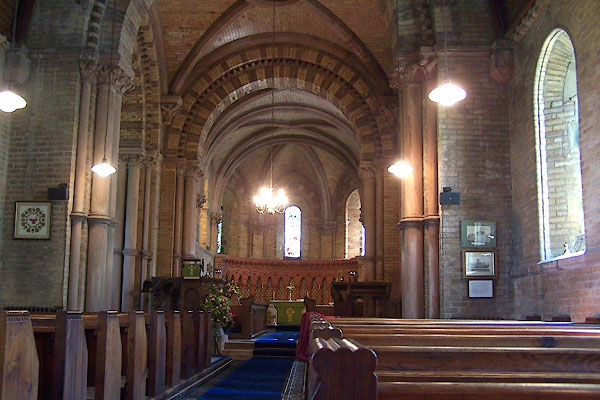
BNV46.jpg (taken 20.6.2007)
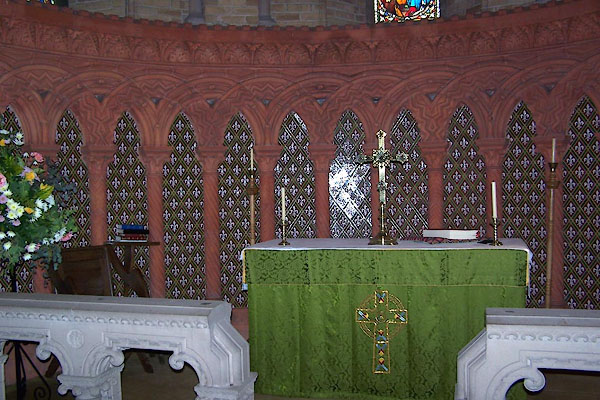
BNV56.jpg (taken 20.6.2007)
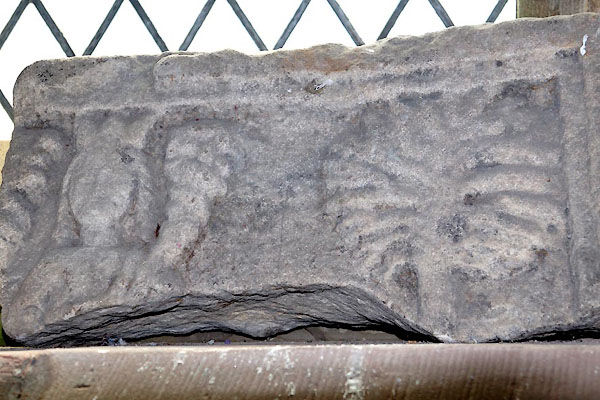
CAU74.jpg Carved stone.
(taken 30.5.2014)

CAU72.jpg Roofing.
(taken 30.5.2014)
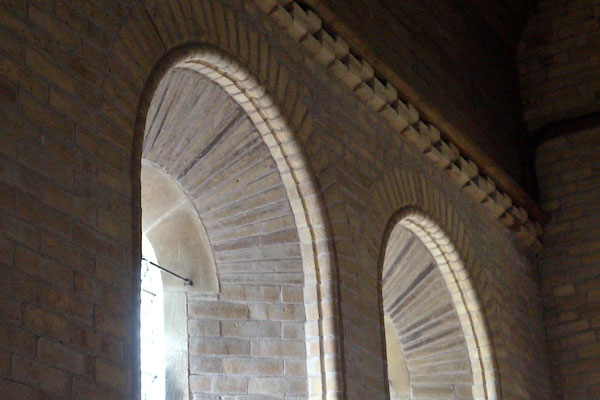
CAU73.jpg Roofing.
(taken 30.5.2014)
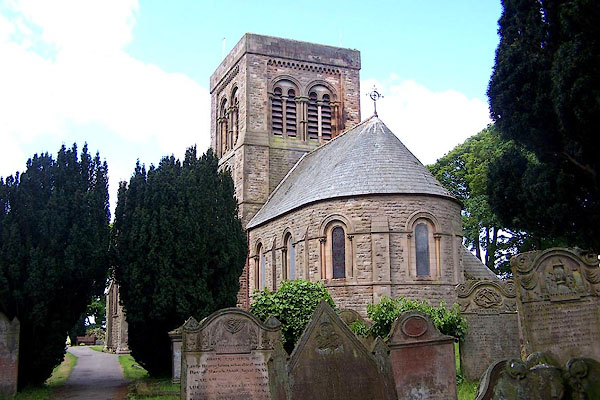
BNR75.jpg (taken 25.5.2007)
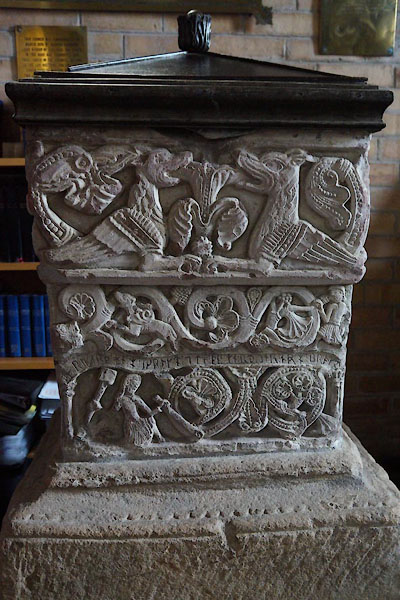
CAU45.jpg Font.
(taken 30.5.2014)
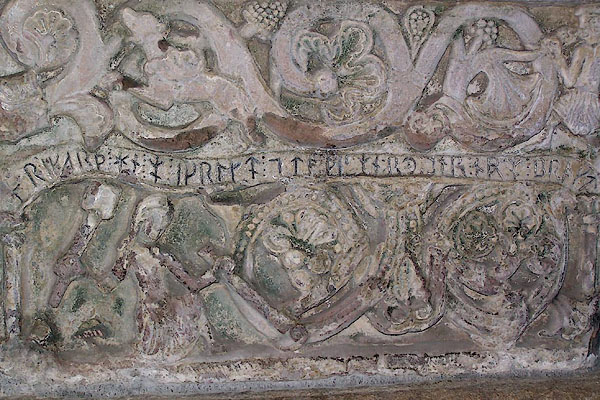
BNV49.jpg Font.
(taken 20.6.2007)

BNV51.jpg Richard of Durham, the mason.
(taken 20.6.2007)
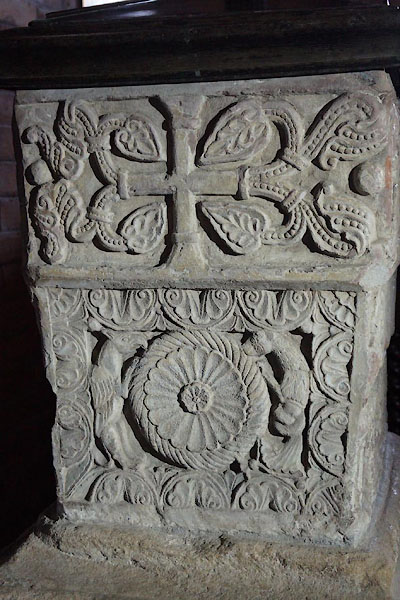
CAU46.jpg Font.
(taken 30.5.2014)
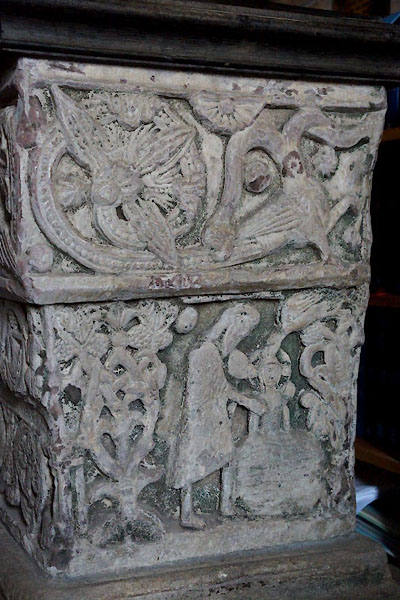
CAU47.jpg Font.
(taken 30.5.2014)

CAU48.jpg Font.
(taken 30.5.2014)
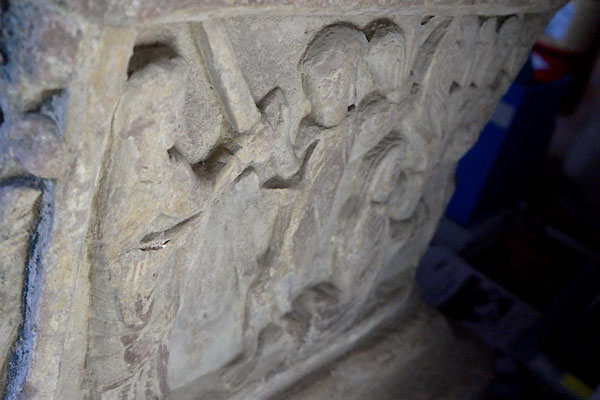
CAU49.jpg Font.
(taken 30.5.2014)
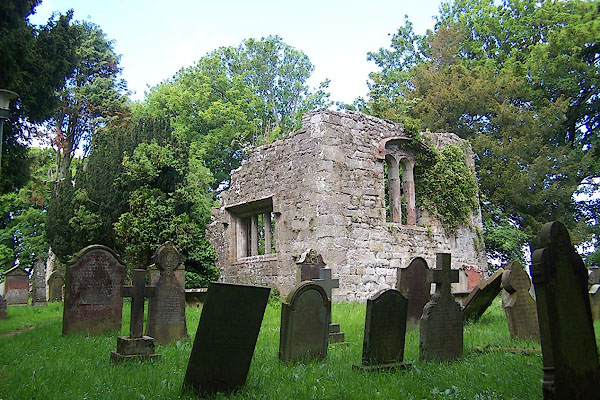
BNR74.jpg The old church.
(taken 25.5.2007)
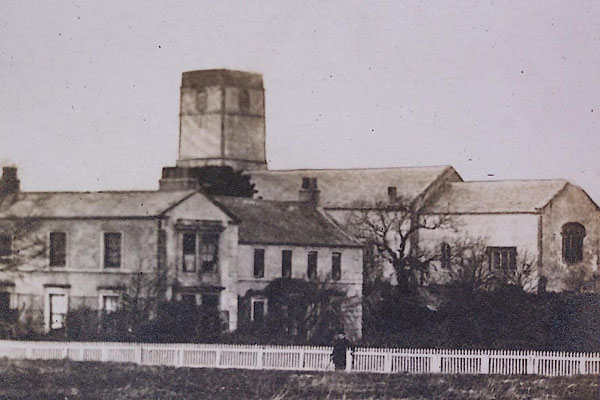
BNV53.jpg The old church before being pulled down, 1868.
(taken 20.6.2007)
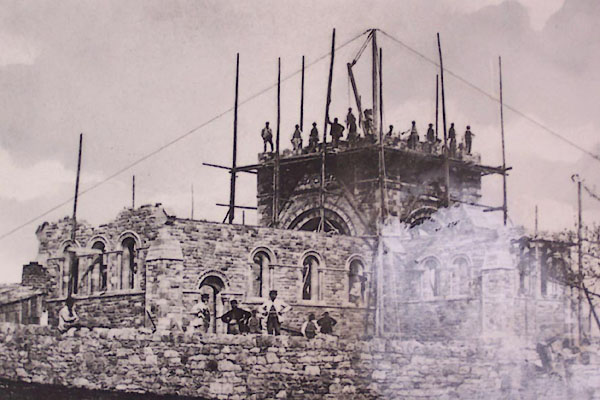
BNV55.jpg The new church being built, 1868; architects, Coy and Ferguson.
(taken 20.6.2007)
